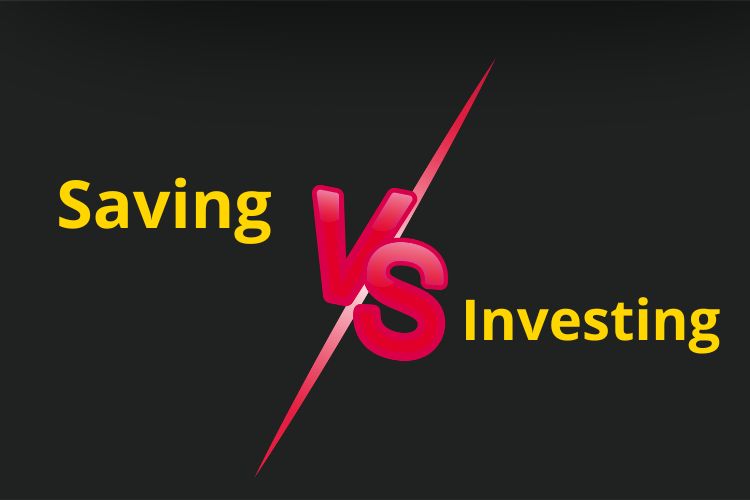Understanding the saving vs investing debate is vital for a balanced and resilient financial plan. While they may sound similar, each plays a distinct role in helping you reach both short-term security and long-term growth.
1. What Is Saving — A Foundation of Financial Safety
Saving refers to setting aside money for short-term goals or emergencies. It’s low risk, often in easy-access accounts.
Key features of saving:
- Low-risk and liquid — your funds stay safe and readily available
- Ideal for an emergency fund or short-term goals like travel or electronics
- Popular tools: high‑interest savings accounts or money market accounts
** Why it matters:** Inflation may slowly erode the purchasing power of saved money, but the benefit is peace of mind and cash for urgent needs InvestopediaBursar’s Office.
2. What Is Investing — Your Tool for Long‑Term Growth
Investing means deploying capital in stocks, bonds, mutual funds, or other instruments to earn higher returns over time.
Important points:
- Higher risk, but higher potential gains
- Best suited for long-term goals like retirement or college funds Affinity Federal Credit Union
- Historical example: $100/week in savings vs investing at 10% returns yields a significant difference — ~$52K vs ~$82.5K in 10 years Affinity Federal Credit Union
** Why it matters:** Investing combats inflation and taps into compounding growth, but requires patience, research, and diversification.
3. Saving vs Investing — Choosing the Right Tool for Each Goal
Time Horizon Matters
- Use saving for goals under ~5 years (e.g., emergency fund, vacation)
- Use investing for goals further out, where market fluctuations can even out over time Bursar’s OfficeAffinity Federal Credit Union
Risk Tolerance & Accessibility
- If you need quick access to funds, saving is the safer bet
- Investing requires comfort with volatility and long-term holding
Compounding Benefits
- Saving early — even small amounts — grows over time due to interest and compounding Bursar’s Office
- Investing benefits from compounded returns, especially over decades

4. Automate Your Way to Financial Success
Automating both saving and investing builds consistency and momentum:
- Set up monthly transfers to a high‑interest savings account and your investment account
- Start small, then gradually increase contributions
- Consider using apps such as Betterment, Acorns, or SoFi for automated investment allocation
5. Common Pitfalls in Saving vs Investing
Avoid these mistakes:
- Waiting too long to invest — time in the market beats timing the market
- Saving everything and investing nothing — inflation will outperform idle cash
- Investing money you need in the short term — too much risk for required liquidity
- Neglecting to adapt your plan as life circumstances change
6. Smart Strategies: Use Both, Wisely
Saving vs Investing.
A healthy financial strategy blends saving and investing:
| Aspect | Saving (Safety) | Investing (Growth) |
|---|---|---|
| Purpose | Short-term security | Long-term wealth creation |
| Risk | Low | Higher, with potential for loss |
| Access | Quick and flexible | Depends on asset/liquidation method |
| Effect of Inflation | Erodes value | Countered via higher returns |
| Best Use | Emergency funds, short goals | Retirement, education, future growth |
7. Starting Early Pays Off — A Compound Interest Story
A compelling comparison from Temple University illustrates how early saving beats delayed saving:
- Sara saves $100/month starting at age 25 for 10 years → ends up with ~$73,500
- Belinda saves $100/month from age 40 for 20 years → ends with ~$46,400
- Lesson: Starting sooner matters more than saving more Bursar’s Office
8. Best Practices in Keyword Use & SEO (Behind the Scenes)
Saving vs Investing.
- Focus keyword “saving vs investing” used in H1, URL, and scattered naturally throughout text
- Variations like “saving early,” “investing long‑term,” “emergency fund,” “high‑interest savings account” in subheadings (H2/H3)
- Short paragraphs, bullet points, bolding for easier reading and scanability
- Image alt text: “Illustration comparing saving vs investing benefits” — concise and descriptive
Final Thoughts: Why You Don’t Have to Choose.
Saving vs Investing.
True financial health comes from harmony:
- Saving gives stability today
- Investing sets the stage for growth tomorrow
Begin with a simple emergency savings plan, then channel surplus into diversified investments.Saving vs Investing let your money work smarter, not harder — and embrace both saving and investing for a stronger future.
See more: Balanced Investment Portfolio Guide: How to Grow Wealth While Managing Risk.
FAQ – Saving vs. Investing.
What is the main difference between saving investing?
Saving is for short-term goals and emergencies — it’s low risk with low returns. Investing is for long-term growth — it involves more risk but offers higher potential returns over time.
Should I save or invest first?
Start by saving an emergency fund (3–6 months of expenses). Once that’s in place, begin investing for long-term goals like retirement or education.
Can I lose money by investing?
Yes. Unlike saving, investments can fluctuate in value. However, historically, long-term investing has provided strong returns that beat inflation.
How much should I keep in savings vs. investments?
Keep enough in savings for short-term needs and emergencies. Any money you won’t need for 5+ years is usually better off invested to grow over time.
Are savings accounts good for growing wealth?
Not really. Savings accounts are safe but offer low interest. To grow wealth, investing in stocks, mutual funds, or ETFs is more effective over the long term.

